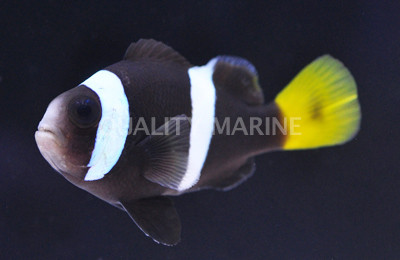Sebae Clownfish (Amphiprion sebae)

Amphiprion sebae is one of the most distinctive species of clownfish, and yet its also one of the most frequently misidentified. A quick Google search of its scientific name reveals that this fish is regularly mistaken for some of its relatives. The most frequent cause for confusion is A. clarkii. In one especially galling example, a prominent aquarium blog published an article purporting to illustrate the diagnostic differences between A. sebae and the species with which it is most often confused, A. clarkii except both of the fishes discussed were variants of A. clarkii! And youre just as likely to see the Sebae Clownfish confused with its sister species, A. polymnus.
But these species are all easily told apart once one knows what to look for, so lets explore how to do so.
First, a bit of backstory on this fishs nomenclature. Aquarists should be familiar with the name Sebae, as it pops up in a few places. Aside from the aforementioned clownfish, there is also the brackishwater African Mono (Monodactylus sebae), one of the most common representatives from its genus within the aquarium trade. And then theres the Sebae Anemone, one of the common names frequently given to Heteractis crispa (though it is sometimes also applied generally to any similar looking anemone). Since this anemone often hosts clownfishes, it is thus possible to have a Sebae Clownfish in a Sebae Anemone, though, as well see, this is not a common occurrence.
Ah, but what does Sebae actually refer to, you ask? That would be the 18th century Dutch apothecary Albertus Seba, who published an enormously important series of illustrated treatises on the natural history of Indonesia. Though he never visited the region, specimens were brought to him by the thousands from the many traders working for the Dutch East India Company returning home from these exotic isles. Amphiprion sebae was one species illustrated in Sebas book, though it would not be given a proper scientific name for more than a century.
Sebas specimen most likely originated from Jakarta, a major trading post at the time. The species is an Indian Ocean endemic; however, it is entirely absent from the western portions. Populations stretch from the Persian Gulf, through the Maldives and Sri Lanka, and further east to the Andaman Sea and south towards Bali. At this point, A. sebae becomes increasingly less common, until it is eventually replaced by A. polymnus, the Saddleback Clownfish. The two are easily distinguished by the color of the caudal finyellow in A. sebae, black in A. polymnus.
Its this yellow caudal fin which causes it to be confused with the ubiquitous A. clarkii sometimes even in areas of the Pacific where A. sebae is not known to occur! For instance, the misinformed aquarium blog that was mentioned previously happened to illustrate the distinctive (and undescribed) population of A. clarkii from the Solomon Islands as A. sebae, despite it having a completely different color in its soft dorsal fin (fully yellow in A. clarkii vs mostly white & black in A. sebae). It also gets mistaken for the yellow-tailed population of A. clarkii found in the Indian Ocean, but that fish features a third white stripe on the caudal peduncle and lacks the broad expanse of yellow that links the anal and caudal fin in A. sebae.
As a member of the saddleback clownfish species complex, a group sometimes treated as the distinct subgenus Paramphiprion, A. sebae is a specialist in sandy lagoons and flats. The most common host anemone in this habitat is Haddons Anemone (Stichodactyla haddoni), but youll also regularly see this clownfish host in the Beaded Anemone (Heteractis aurora) and the closely related Sand Anemone (Heteractis malu), and even on rare occasion in the Long-tentacle Anemone (Macrodactyla doreensis). Aquarium specimens will likely accept any of these, as well as others from these genera, though they arguably look most appropriate in S. Haddoni. This is certainly the most colorful option.